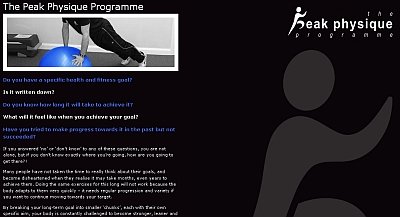The Peak Physique Programme
by Paul Swainson
(Leeds, UK)

The key to The Peak Physique Programme's success is the focus on ‘resistance' training, which is the concept of using muscles to produce force - be it to move your body, lift a weight, or maybe hold yourself in a certain position.
Traditionally, the fitness industry has promoted cardiovascular, or ‘CV' training (running, cycling, swimming, etc) as the best way to lose weight, with emphasis on prolonged workouts at a low-intensity to ensure you are in the so-called ‘fat-burning zone'. Whilst CV training is fantastic for increasing aerobic fitness and enhancing health (through improving the efficiency of the heart and lungs), there are two main reasons why you should not rely on this method alone if you also want to achieve (and maintain) significant changes to your body shape.
The first is quite simple - without resistance training your body has no reason to preserve its calorie-burning lean tissue (muscle). The body is very efficient at adapting to demands placed upon or taken away from it. By making your muscles work, it is being told you need those muscles and will hang onto them. By only doing CV training, your body doesn't need any extra muscle and will break it down to provide energy. So, yes you will lose weight, but as some of it is muscle you will also lose shape. Plus, as muscle is metabolically more active than fat, reducing it means your metabolism will fall, so you won't burn as many calories at rest as before.
The second reason is a little more complex and relates to the energy actually used during your workouts.
For the human body to use fat as an energy source, oxygen is required to facilitate the necessary metabolic reactions. Oxygen is readily available to the body at rest and very low exercise intensities - this is the reason the ‘fat burning zone' is set at a relatively low level. The problem is that because the exercise intensity is so low, not many total calories are burned unless the training session is very long (at least 1-2 hours, in addition to a warm up and cool down).
Not many people have the time for this length of workout (not to mention the boredom factor!) and so opt for shorter, harder training sessions. As exercise intensity increases though, the body requires more and more oxygen but cannot process it quickly enough to produce energy. The deficit is made up by burning carbohydrates instead, a process which doesn't need oxygen immediately.
So, you can be reasonably sure that if your CV workout is less than an hour in length, either a) most of the calories burned will be from carbohydrates, or b) the session is at such a low intensity that an insignificant amount of calories will be burned at all.
However, next comes the interesting part. After a workout, the body still requires a higher than normal energy supply to help recover from the session (e.g. to repair damaged cells, clear free radicals that are produced during exercise and replace the muscles' carbohydrate stores ready for the next workout). This is what is known as a 'raised metabolism'.
The energy for an increased metabolism comes from proteins, carbohydrates and fats. In turn, these can come from food or from stores within the body (e.g. breakdown of muscle as mentioned earlier). If the body is not exercising, it is effectively functioning at a low intensity, or is completely at rest (sleep). As discussed above, oxygen is available at low intensity and so fat can be used more readily. Therefore, a carefully balanced post-workout meal will provide proteins and carbohydrate so that only the fat comes from stores within the body.
So, we have seen that fat calories continue to be burned at a higher rate than normal after exercise. A key point now is that the harder the exercise session, the longer the metabolism will be raised for afterwards to recover (think about how long you keep breathing heavily for to take in more oxygen, after you have stopped exercising).
This is where resistance training comes in. In a resistance exercise, the muscles involved are fatigued in very short time periods (anywhere between 10 and 120 seconds). Compared to CV training, this is very intense (imagine how hard you would have to cycle to tire the legs out in less than two minutes!). This means that almost 100% of the energy comes from carbohydrates as there is hardly any time for oxygen to be processed. In turn, following a resistance training session, metabolism rockets in order to help the muscles recover. The body takes in vast amounts of oxygen and uses fat as it's primary energy source. With the right training systems, this ‘after-burn' effect can last up to 24 hours - you'll burn far more calories between workouts than during them.
The Peak Physique Programme is one such system. It has been designed to elevate metabolism so that your body is burning more fat, more of the time, even while you sleep. By definition, high-intensity exercise is very stressful on the body which is why adequate preparation must be made to prevent injury and ensure the training is effective. This is the reason for the three phases of the programme, training your body to ‘earn the right' to perform the Results Phase exercises.
Check it out here - http://peakphysiqueleeds.co.uk
Comments for The Peak Physique Programme
|
||
|
||
